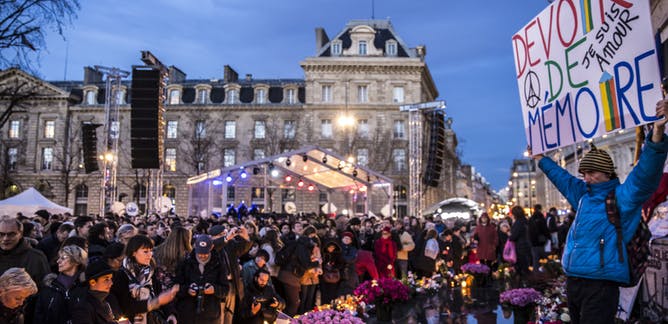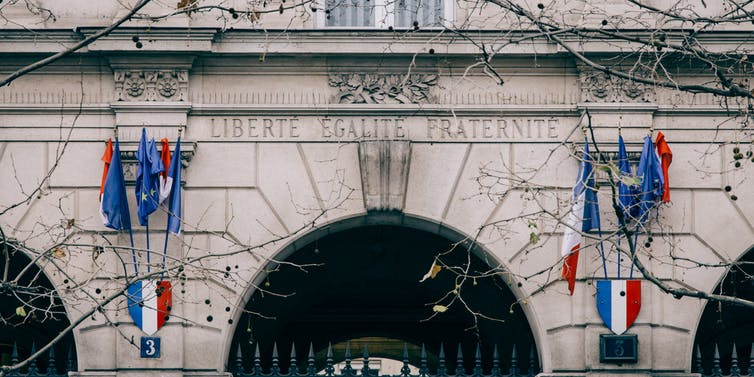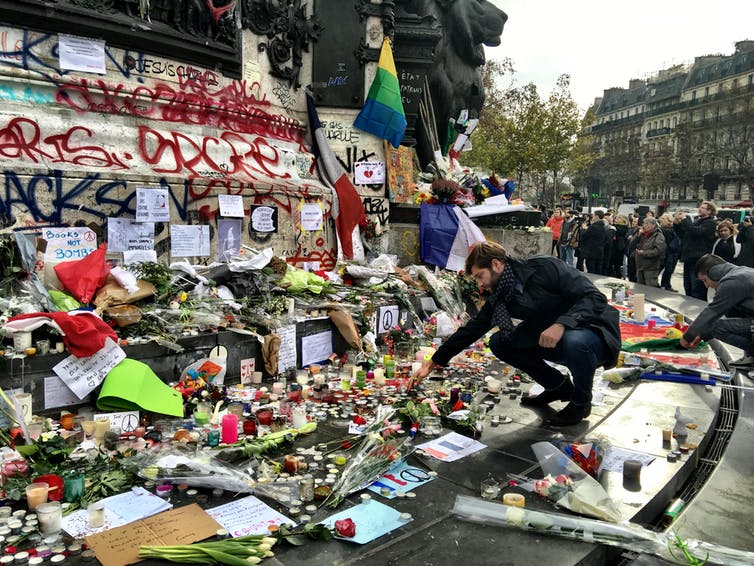Shutterstock
Guest post by Elizabeth Benjamin, Coventry University
It has been three years since gunmen attacked the offices of French satirical newspaper Charlie Hebdo, killing 12 people. In the days that followed, five more lost their lives while police hunted for the perpetrators – brothers Cherif and Said Kouachi. Eventually, they were shot dead after an eight-hour standoff involving hostages.
In the aftermath of these events, time stood still. Christmas decorations eerily remained well into February in streets and stores, as civilians and leaders from across the globe gathered in Paris to mourn the victims and condemn terrorism. Online, the slogan “Je suis Charlie” (I am Charlie) went viral, as millions of individuals expressed a shared sentiment and solidarity.
These events, and the way they have been memorialised since, have triggered a shift in some elements of French national identity – the collection of ideas, symbols and emotions that define what it means to be French – particularly the national motto, “liberté, égalité, fraternité” (liberty, equality, fraternity).
Set in stone? Arianta/Flickr, CC BY-NC
In the past, greater emphasis was placed on liberty, in rebellion against the oppressive monarchy of ancient France. But in response to the recent trauma, fraternity – or solidarity – has taken centre stage, even appearing as a background to Macron’s promise for a “French Renaissance” in 2018. Today, fraternity represents the peace and sorrow of remembering the dead, rather than the violence and anger of the French Revolution.
The meaning of liberty itself has shifted to focus on a specific freedom – the freedom of speech, which the terrorists sought to silence. And the French sense of equality now resonates poignantly with Charlie Hebdo’s renowned mission to mock everyone equally. In the aftermath of terror, the ideals of France’s past have subtly morphed, as its people look for ways to defend the right to free speech, while mourning the harsh reality of its cost.
Death in Paris
Memorialisation has always played a key role in modern cultural memory, and this is particularly clear in Paris. As a city, Paris is separate from the rest of the country, yet it also represents the French Republic. Even the name for the region of Paris, “Île de France” (Island of France), expresses isolation while proclaiming to stand for the nation as a whole. Paris has come to be accepted as a cultural hub, as the French centre for fashion, publishing, and language.
Death and terror have a long history in Paris. Even the word “terrorism”originates from “The Terror”; a period of violent purges of those opposed to the new national ideals in the wake of the French Revolution. From the subterranean, bone-lined Catacombs to the Place de la République, the display and commemoration of death has always been a feature of the French capital.
Yet it is perhaps fitting, in the internet age, that the most recognisable memorials for the Charlie Hebdo attack are not just static landmarks, but visual, virtual and transient. One year after the attacks, commemorative plaques were dedicated by then-President François Hollande, and a tree was planted in the Place de la République, creating a living memorial.
Charlie Hebdo also ran a cover commemorating the dead, while targeting religious extremism: a blood-spattered, God-like figure runs away with a Kalashnikov, under the slogan “one year on, the assassin is still out there”. Solidarity sales of the struggling publication grew following the attacks – though they lessened on the first anniversary, and dwindled again with the second – and the covers marking each anniversary have spread across social media.
One year later: The Cover of Charlie Hebdo on 7th January 2016 pic.twitter.com/lRIhgGMxqU
— CTV F1 (@CTVGER) January 4, 2016
This year, the publication will run another cover, commenting on the enduring impact of memorialising the attack and the continued cost of free speech. In some ways, the magazine itself has become a symbol, and each of its anniversaries covers a new thread woven into the new French identity.
The politics of memory
Whether or not Parisians agree with Charlie Hebdo’s editorial line, it is likely that they will gather in the Place de la République – as they have in previous years – to express their solidarity with the victims, and their defiance in the face of violent extremism. And so the square itself has become one of France’s longest living memorials; a place where people gather to light candles and place flowers and notes.
A place to remember. Roberto Maldeno/Flickr, CC BY-NC-ND
Paris’s many sites of public remembrance express what it means to be French – and provide a site to contest it. The monuments of Paris have often highlighted ideological issues around memorialisation in the city. The Mémorial des Martyrs de la Déportation has been criticised for presenting the Jewish experience of WWII as one shared by all in France. The Panthéon – a prominent tourist centre for French cultural history – houses only five female members alongside its 76 men.
The same is true of the Charlie Hebdo memorials; in 2015, flowers and notes were not the only things left on the statue at the centre of the Place de la République. It was also scrawled with graffiti condemning terrorism and extremism in all its forms. Likewise, the mural outside the offices of Charlie Hebdo, depicting the victims of the attack, was recently defacedwith Hitler moustaches – a protest, perhaps, against the victims’ new-found hero status.
Amid all this conflict, there is some reassurance to be found: Paris’s contested sites and spaces are proof that freedom of speech is alive and well in France. Satire, after all, has a longer history than terrorism.
Originally written for ‘the Conversation’.






Comments are disabled